The Idea
Add a Multimedia Studio space to the Mack High School Library for academic and personal creative learning experiences. Trained staff will be available for programs and in-person or virtual guided workshops. The studio will be open to students, teachers, and staff at MHS and will be designed for HOMAGO – a space where students can Hang Out together, Mess Around with the technology, and Geek Out by creating original content (Yollocalli Arts Reach, 2013).
The studio will include:
- computers equipped with image-, video-, and sound-editing software,
- cameras, lights, and microphones, and
- a small, sound-proof recording space.
Users will be able to:
- record video and audio,
- edit photos, videos, and sound,
- scan or upload existing content,
- share creations with teachers or on various social media platforms,
- post creations for display in the library, and
- check out circulating laptops, cameras, microphones, headphones, and tripods.
Community
MHS is a small high school in a rural area. The school district’s Local Control Accountability Plan reports that over 43% of students are socio-economically disadvantaged and in need of additional academic support (NHUHSD, 2025). Concerns include declining academic motivation and school connectedness. Goals were set to create community-building activities where students can meaningfully participate and to develop project-based learning that involves student voice and choice.
Implementing a Multimedia Studio in the school library aids district goals. Students can actively design the space and use it to learn new skills. This is especially important for students who would not otherwise have access to technology or guided learning opportunities. The studio will connect them to the school as well as allow them to make connections to future aspirations.
Goals & Objectives
Goal I: Increase digital literacy skills through creative exploration.
Objective 1: Integrate digital tools into library programming.
In an effort to connect students with their school and develop a greater sense of belonging, the technology, space, and workshops will be integrated into an existing community space. Students will help design and choose the elements that are the most important and of interest to them to help prepare them for future college and career aspirations.
Objective 2: Promote inclusive and equitable access to technology.
To bridge the digital divide in the community, access to the studio’s technology will be made available during various hours of the day. Additionally, trained staff will be onsite to aid students as well as to run guided learning workshops.
Goal II: Minimize learning loss through creative engagement.
Objective 1: Encourage student-led exploration.
In order to create a method for meaningful participation by students, they will lead the growth of the studio project. Programs and workshops will be designed based on student request and input, and peer-to-peer tutoring and engagement will be encouraged.
Objective 2: Develop interdisciplinary learning opportunities.
To support the academic achievements of students, collaboration with teachers and staff will create avenues for project-based learning that can connect to real world applications.
Mission & Institutional Context
A Multimedia Studio will align with district, school, and library mission statements by supporting students’ personal and academic growth and by providing resources to encourage lifelong learning. This can lead to a successful integration of a new technological service while not overwhelming staff (Stephens, 2004).
The school district will… “provide the highest quality, comprehensive education in a safe, supportive environment, by promoting a culture of academic excellence, innovation and creativity; ensuring an outstanding, passionate staff committed to student achievement; encouraging acceptance of and appreciation for diversity; and offering a wide range of curricular and extracurricular activities for all students” (NHUHSD, n.d.).
The school site will… “foster an inclusive community where all individuals can excel both personally and academically by empowering learners with meaningful skills in a safe and supportive environment” (MHS, n.d.-a).
The school library will… “provide access to current, adequate and appropriate information resources and ensure that all students and staff members are effective users of ideas and information” (MHS, n.d.-b).
Action Brief Statement
Convince high school students at MHS
…that by: using the Multimedia Studio in their library
…they will: learn new skills and create new content
…which will: help them with class assignments and add to their skill sets and resumés,
…because: through creativity and digital literacy they can be confident and successful in future academics & careers.
Inspiration
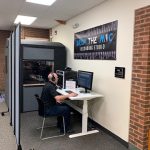 Charles County Public Library |
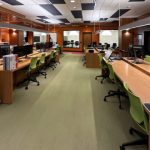 Fountaindale Public Library District |
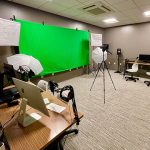 Martin Public Library |
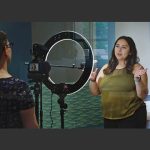 Topeka & Shawnee County Public Library |
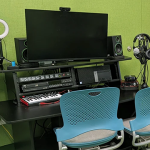 Wichita Public Library |
The Strategy
Timeline for Implementation
Fall – Define Goals
- library staff define project goals
- bring project to district/school administration and IT department
Winter – Inform Users
- benchmarking, community/equity analysis
- bring project details to teachers and staff
- bring project details to students
Spring – Get Feedback
- teacher department meeting discussions and use surveys
- student focus group discussions and use surveys
Summer – Install & Train
- survey analyses
- space setup and equipment installation
Fall – Use & Evaluate
- introduce space to teachers, staff, and students
- test use, survey, and evaluate
- offer ongoing learning/training opportunities
Guidelines & Policies
Library and IT staff are tasked with student, facility, and equipment safety and so will be the ones to create policies that align with school rules and guidelines.
Multimedia Studio Policies
- Everyone is welcome to participate, both in-person and online.
- Respect the space, equipment, each other, and yourself.
- Keep content school-appropriate – no discriminatory, derogatory, or offensive content.
- Use headphones and inside voices, especially during recording sessions.
- Keep food and drinks put away to protect technology.
- Embrace new ideas and be willing to adapt.
Marketing & Promotion
The Multimedia Studio will be promoted through various channels including in person announcements, visual displays, and collaborative efforts. Communications by students, for students will be emphasized through student-led social media posts and videos.
On Campus
- Announce during other library programs & events
- Collaborate with teachers and students to announce in classes
- Post fliers around campus, in offices, classrooms, and the library
Off Campus & Online
- Post digital fliers on the school’s and library’s websites
- Create and post collaborative videos with students to introduce the space to their peers
- Post to the school’s social media accounts
- Post to the school’s newsletter to families
Staff Training & Readiness
Library staff will receive training for the use of equipment and technology as well as the necessary software. This will be aided by IT staff or by outside professional development opportunities.
The library can then offer workshops for students, teachers, and staff to learn new skills. These may be in-person or created as online and asynchronous tutorials. As new ideas emerge through participation and exploration, additional training may be undertaken collaboratively.
Evaluation & Future Expansion
Evaluation will be based on both observed use by library staff and anecdotal feedback. Students sharing their original content for library displays or school social media posts as well as for projects submitted as class assignments will inform library staff and administration of use. Student and staff feedback about the studio’s limitations or possibilities for additional equipment will be valuable in assessing future adaptations. Though technology will continually be evolving and library staff should be open to any changes, the needs and interests of the students (and budget restrictions) will determine how and to what extent the Multimedia Studio will expand (Stephens, 2019).
References
Casey, M. & Stephens, M. (2008, April 15). Measuring progress. Tame the Web.
Charles County Public Library. (n.d.). Drop the Mic Recording Studio.
Fountaindale Public Library. (n.d.). Studio 300.
Martin Public Library. (n.d.). Sound and Video Recording Studio.
McKinleyville High School. (n.d.-a). Our vision.
McKinleyville High School. (n.d.-b). Welcome to the library!
Northern Humboldt Union High School District. (n.d.). Vision, mission and goals.
Northern Humboldt Union High School District. (2025). LCAP.
San Francisco Public Library. (2024). Vision 2030: San Francisco Public Library strategic plan: 2024-2030.
Stephens, M. (2004, November 1). Technoplans vs. technolust. Tame the Web.
Stephens, M. (2019). Wholehearted librarianship: Finding hope, inspiration, and balance. ALA Editions.
Topeka & Shawnee County Public Library. (n.d.). Level 2 Tech Center.
Wichita Public Library. (n.d.). AV Studio.
Yollocalli Arts Reach. (2013, February 13). HOMAGO guidebook. Issuu.
Leave a Reply